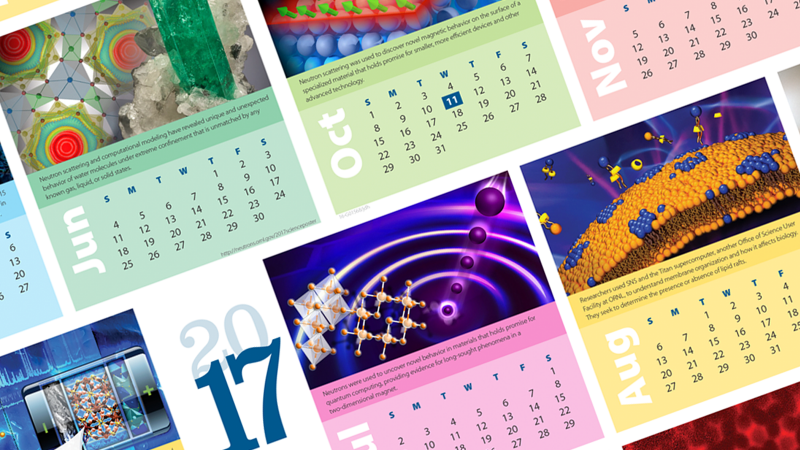New for 2017 is a poster highlighting 12 examples of research from SNS and HFIR. You can download a printable version of the poster here: ORNL_NScD_Poster_17x11.pdf.
For more information on the scientific research and publications featured each month, visit these links:
- January: Neutron scattering was used to uncover magnetic excitations in the metallic compound ytterbium-platinum-lead (Yb2Pt2Pb).
https://www.ornl.gov/news/neutrons-reveal-unexpected-magnetism-rare-earth-alloy
- February: Neutron analysis was used to better understand a protein implicated in the replication of HIV, the retrovirus that causes AIDS. The enzyme, known as HIV-1 protease, is a key drug target for HIV and AIDS therapies.
https://www.ornl.gov/news/neutrons-probe-structure-enzyme-critical-development-next-generation-hiv-drugs
- March: Neutron and X-ray diffraction were used to identify compositions of garnet for targeted future optimizations as a solid-state electrolyte in advanced lithium batteries.
http://onlinelibrary.wiley.com/doi/10.1002/aenm.201500096/abstract
- April: A new technology to squeeze materials with a million times the pressure of Earth’s atmosphere while studying them with neutrons has been developed with potential to provide an unprecedented picture of the changing nature of matter under extreme pressure.
http://neutrons.ornl.gov/news/pressure
- May: ORNL and its collaborators were recognized recently for the discovery of elements 115 and 117. The berkelium target material was produced during a 6-month irradiation in the world’s most intense thermal neutron flux at ORNL’s High Flux Isotope Reactor.
https://www.ornl.gov/news/ornl-team-officially-recognized-elements-115-117-discovery
- June: Neutron scattering and computational modeling have revealed unique and unexpected behavior of water molecules under extreme confinement that is unmatched by any known gas, liquid, or solid states.
https://www.ornl.gov/news/ornl-researchers-discover-new-state-water-molecule
- July: Neutrons were used to uncover novel behavior in materials that holds promise for quantum computing, providing evidence for long-sought phenomena in a two-dimensional magnet.
https://www.ornl.gov/node/25901
- August: Researchers used SNS and the Titan supercomputer, another Office of Science User Facility at ORNL, to understand membrane organization and how it affects biology. They seek to determine the presence or absence of lipid rafts.
https://www.olcf.ornl.gov/2016/03/31/broadening-the-bilayer/
- September: A novel technique known as in-situ plasma processing is helping scientists get more neutrons and better data for their experiments at ORNL’s Spallation Neutron Source.
http://neutrons.ornl.gov/news/plasmaprocessing
- October: Neutron scattering was used to discover novel magnetic behavior on the surface of a specialized material that holds promise for smaller, more efficient devices and other advanced technology.
https://www.ornl.gov/news/neutrons-tap-magnetism-topological-insulators-high-temperatures
- November: A new statistical analysis technique has been developed to use diffuse scattering data to understand potentially exploitable properties of crystalline materials.
http://scripts.iucr.org/cgi-bin/paper?S1600576716001369
- December: Neutrons were used to help uncover a “greener” way to control the assembly of photovoltaic polymers in water using a surfactant—a detergent-like molecule—as a template.
http://neutrons.ornl.gov/news/nanoscale-solarcells






